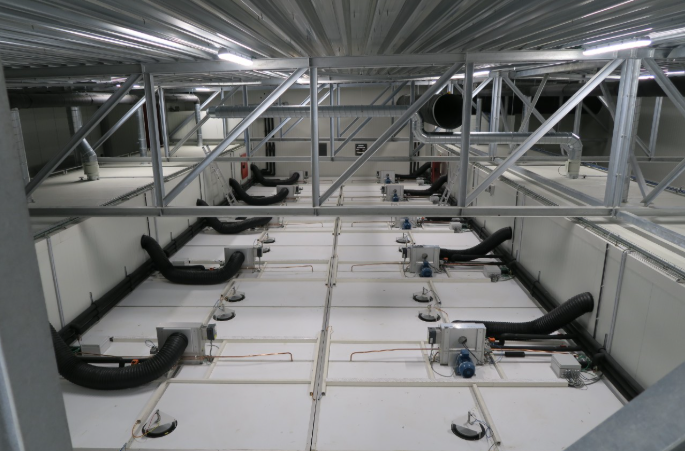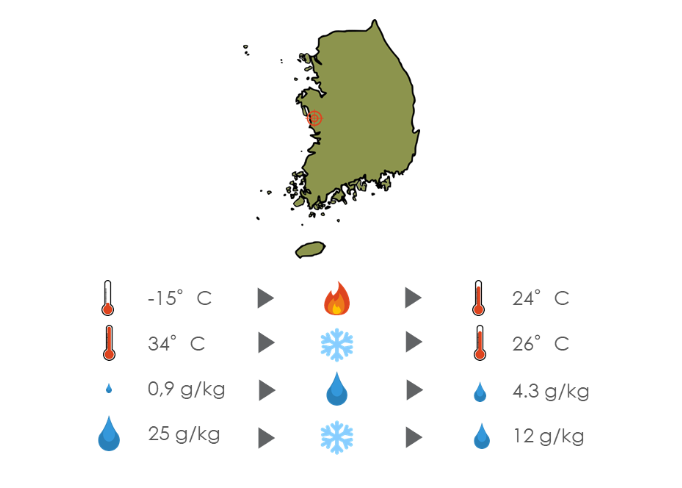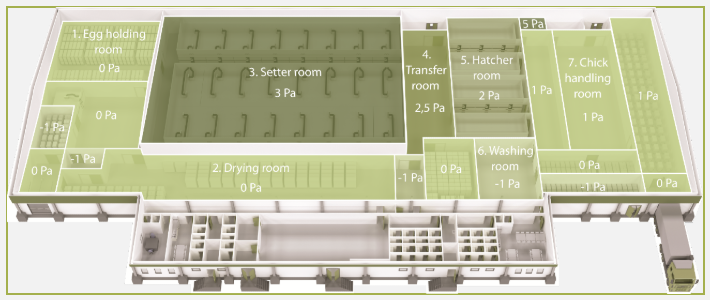



The role of HVAC systems in single-stage hatcheries
Since the evolution of the hatchery industry from multi-stage to single-stage incubation, Heating, Ventilation and Air Conditioning (HVAC) systems have become an indispensable part of hatchery operations. In essence, the HVAC system does the heavy lifting when it comes to climate control in single-stage hatcheries, and thereby helps the incubators achieve an optimal yield. The importance of climate control stretches far beyond the conditioning of the air for setters and hatchers, as controlling the air conditions in every room, from the reception of eggs to the dispatch of chicks, in a single-stage hatchery is essential to achieving optimal hatchery results.

Single-stage incubation relies on HVAC
Even though the commercial incubation industry had long adhered to the multi-stage incubation methodology (and successfully so), a new approach was required to both fulfil the worldwide demand for more poultry meat while meeting ever-stricter levels of biosecurity, and optimise the industry’s efficiency and return on investment.
Apart from retraining the personnel to the single-stage way of working, it also requires adapted machinery and equipment, including a properly-dimensioned Heating, Ventilation and Air Conditioning system. An effective and customised HVAC system is indispensable forefficient single-stage operations, as this technology does the heavy lifting when it comes to heating, cooling, humidifying and dehumidifying the fresh air supply that feeds the incubators. This makes it easier for the incubators to finetune the embryo’s environment for optimal hatchery results.
In this article, we focus on the four ways an effective climate control system impacts a single-stage hatchery for the better.
1. The right air supply at every stage
Arguably the biggest advantage of single-stage incubation is that environmental conditions can be adjusted to the needs of the embryo at every development stage, from egg to chick. Not only does this improve the hatchability and chick uniformity as a result of an improved hatch window, but it also makes it easier to guarantee the biosecurity within the hatchery.
The HVAC system ensures that the correct volumes of air, conditioned both in terms of temperature and humidity, are delivered to the setter and hatcher room at all times. This allows the actual setters and hatchers to finetune the temperature and flow of the air and provide optimum and uniform environmental conditions inside the machines.
2. Any location, any climate
Outside climate conditions not only vary from region to region, but from season to season and even from day to night as well. That’s why Petersime designs and engineers HVAC systems based on historical geographical climate data, that take into account the actual minimum and maximum temperature and variations in humidity levels during a given time span.

Example: A hatchery in South Korea
In South Korea, temperatures can easily range between -15°C and 34°C, while absolute humidity levels can rise from 0.9 g/kg up to 25 g/kg. A well-designed HVAC system will adjust the air conditions in the hatchery by heating the air in winter and cooling it in summer, while at the same time adjusting the level of humidity as required by the incubation process.
3. Increased biosecurity: no more airborne cross-contamination

A well-designed HVAC system will increase the hatchery’s level of biosecurity, as a pressure-controlled airflow is able to create different pressures in different rooms.
The highest pressure should be maintained in the setter room and the vaccine room — where cleanliness is paramount — while the lowest pressure is reserved for the washing rooms and areas that house dirty baskets. If ever a door opens, the air will always flow from the most vital and clean rooms to the dirty rooms, and especially never the other way around.
The HVAC system also filters the fresh incoming air. In fact, Petersime recommends using two levels of air filtration: first, a G4 pre-filter to keep out particles visible to the eye (>10μm); and secondly, a main F7 filter which blocks out fine dust and particles larger than 1μm. In this way, the hatchery only draws in clean air, while dirty air is contained in the designated rooms until being exhausted from the building.
4. Keeping energy costs in check
A well acclimatised hatchery does not necessarily consume more energy. Provided it has been properly engineered, a customised HVAC system can even help hatcheries consume the lowest amount of energy possible. In fact, the same pressure control system monitors how much air is required and will only provide that specific volume of air, so no conditioned air is wasted.
Moreover, in cold climates, it is possible to recover heat from the developing embryos, as from day nine onwards, the embryos are in their ‘exothermic phase’ (which means they start to produce more heat). A sustainable HVAC system can use this heat to pre-heat the cold fresh air entering the hatchery, thereby dramatically reducing the boiler’s and chiller’s energy consumption; indeed for the latter, this can sometimes be brought down to zero.
Leave your hatchery’s HVAC to Petersime
To ensure you end up with an ideal setup for maximum output and the best quality results, it is best to have one single company design and engineer your entire hatchery, including the HVAC. Petersime's Project Department has over 35 years of experience in designing and installing tailor-made HVAC systems for hatcheries in the most varied climates.
Our experts believe that there is no single, standard solution for HVAC. Hatcheries in hot, humid climates, for example, require an air conditioning system designed for cooling and dehumidification, whereas heating and humidification is a must in cold environments. We are therefore ready to custom-build each of our HVAC systems to suit the conditions that prevail in your area. Please don’t hesitate to contact us for more information.








